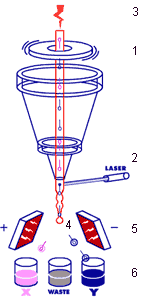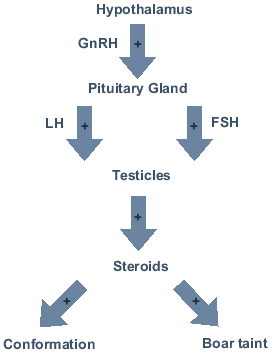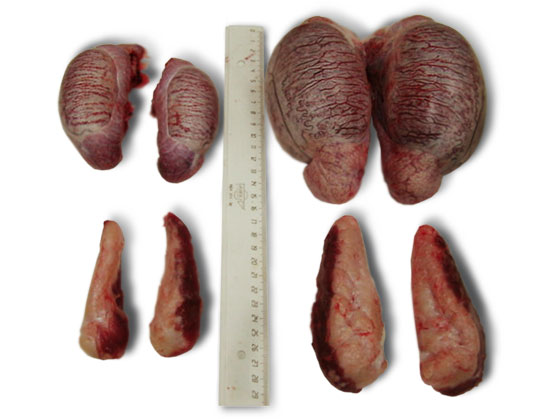Spermatic selection consists of the sexing of the spermatozoids with the objective of producing only females. The methodology used to separate the spermatozoids with the X chromosome from those with the Y chromosome is called flow cytometry (Figure 1). This method is based on the difference in size of the DNA of both chromosomes which gives them a different electrical charge. There are currently 4 laboratories in the world which are equipped with this system (USA, Australia, Germany and Italy). This technique only permits between 10 and 15 million spermatozoids to be processed per hour. Therefore, it would take up to 5 hours for one machine to produce one dose of sperm, making its use not very practical at present.
Figure 1. Diagram of flow cytometry (http://www.xyinc.com)
 |
1. A piezo electric crystal is ondulated approximately 90,000 times/second, which breaks the stream into droplets at a particular point in time. The location of the last-attached droplet in the stream is highly controllable. 2. An X- or Y-bearing sperm is compared to a preset sort criteria. 3. After a time delay, the insertion rod is charged. 4. A charge is applied at the time the cell reaches the last attached drop. 5. The charged droplets are deflected as they pass between continuously charged plates. 6. Particles not meeting the criteria pass straight down to waste. |
Immunological Castration
Immunological castration consists of the stimulation of the immune system of the animal so that it can produce specific antibodies, in this case against GnRH (gonadotropin releasing hormone). These antibodies inhibit the normal activity of GnRH, reduce the plasmatic concentrations of LH and FSH, and inhibit testicular development and functioning (Figure 2). In this way the levels of androstenone and skatole in the fat are reduced, and therefore the incidence of boar taint in the carcasses is also reduced. Immunization against the pituitary hormone LH has also been tried, although it turns out to be less effective. The administration of the immunological product is performed by injection, normally subcutaneously behind the base of the ear. This practice seems to be less painful and stressful for the animal than surgical castration without anesthesia, although there are no studies to confirm this.
Figure 2: Hypothalamic-pituitary-gonadal axis

In order for this method to be commercially viable, the immunological product has to induce a sufficient antibody titer with few administrations. Moreover, it has to be tolerated by the animals and its components must be safe and acceptable for consumers. Immunological castration of intact boars has been achieved by administering two injections with an interval 4-8 weeks between injections. It is the second dose that provokes the immunological reaction with a high titer of antibodies against GnRH. In this way, until the second injection the animals maintain the advantages of an intact boar, fast growth and a greater disposition for lean. After the second administration, the size of the testicles and of the bulbourethral gland are reduced (Photo 1), and the androstenone and skatole are metabolized and they progressively disappear from the fat tissue of the animal. The levels of both components in carcasses of pigs castrated immunologically are very similar to the levels in surgically castrated pigs. Immunological castration also reduces sexual behavior and aggressiveness during the final weeks of fattening (Cronin et al., 2003), in this way increasing the time dedicated to the ingestion of food (Dunshea et al., 2001). This change in behavior provokes a greater growth during the final weeks and a higher fat content in the carcass compared to the intact boar (although it is lower than in pigs castrated at an early age).
Photo 1: Size of testicle and bulbourethral gland in intact and immunologically castrated males.

In Australia, an immunological product has recently been developed which provokes active immunization against GnRH. It is administered by two subcutaneous injections, the first at least four weeks before the second, and the second 4-6 weeks before slaughter. In this way, the presence of the boar taint is eliminated in the carcasses of the treated animals. Studies carried out in Australia (Dunshea et al., 2001) and Switzerland (Jaros et al., 2005) indicates that after the second injection the presence of the boar taint is eliminated, the content of intramuscular fat increases, and testicular size is reduced. In the latter study, of 270 animals to which the product was administered, 2 showed higher than acceptable levels of androstenone in fat. However, with this immunological product, the animals that do not respond to the treatment are easily identified at the slaughter line. It is calculated that 25% of the male pigs produced in Australia are immuno-castrated (EFSA, 2004). The product has recently been approved for commercialization by the Spanish agency of medicine.




